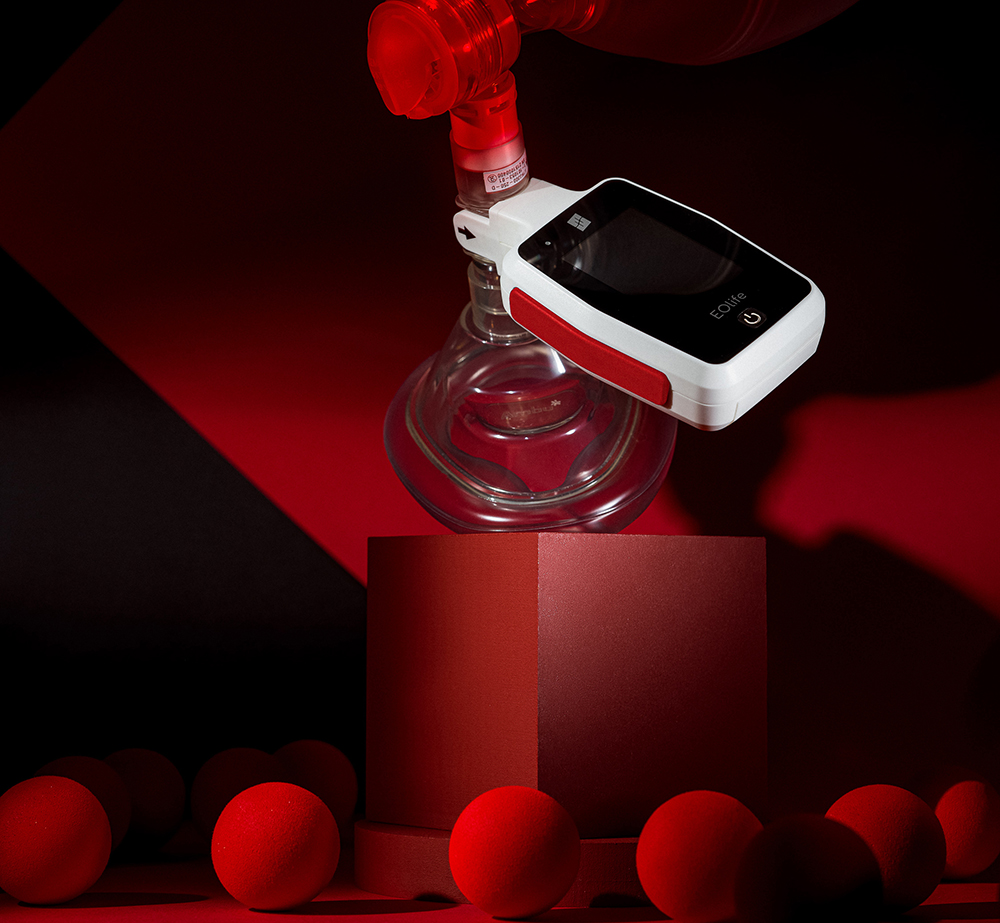
per year in the United States.
Besançon, France: The first intelligent manual ventilation assistance system, EOlife®, has received market authorization from the Food and Drug Administration (FDA) in the United States. After two years of commercialization in Europe, this marks a crucial milestone for Archeon, which aims to standardize high-performance ventilation practices.
A REVOLUTIONARY TECHNOLOGY
EOlife® is the first device that measures ventilatory parameters and provides real-time feedback on the quality of manual ventilation delivered to a patient in cardiac arrest. Oxygen is considered an essential survival medication ([i]), yet it is administered without any dosage. EOlife® is the only device that enables rescuers to ventilate in compliance with both American Heart Association and European Resuscitation Council guidelines.
“The next step to ensure the highest quality ventilation is to use the device pre-hospitally to accurately measure ventilation parameters, especially ventilation frequency and tidal volume,” explain Prof. Mohamud Daya and Dr. Matthew Neth, respectively EMS Section Chair and Assistant Professor at the Oregon Health & Sciences University.
ADDRESSING MULTIPLE PUBLIC HEALTH CHALLENGES
While the survival rate in cardiac arrest is only 5%, well-conducted ventilation doubles the chances of survival ([ii]). EOlife® improves the quality of manual ventilation by over 70% while reducing the risks of hyperventilation by 10 times ([iii]). Proper ventilation enhances survival chances, limits long-term lung damage, and reduces time spent in intensive care ([iv]). The use of EOlife® in the United States could save at least 25,000 lives annually and result in savings of nearly $20,000 per patient ([v]).
“It is time for health authorities and professional societies, such as the American Heart Association, to take action to regulate manual ventilation practices in emergencies, now that it is possible to control oxygen administration to the patient. It is simply unacceptable that such a vital procedure as manual ventilation is not better taught and controlled; things need to change,” says Alban De Luca, co-founder of Archeon.
“The device developed by Archeon Medical improves the quality and safety of ventilation in all patients undergoing manual ventilation. With proper training, this device can be quickly and easily implemented in pre-hospital and hospital settings.” Dr. Joseph Finney and Dr. Fahd Ahmad, respectively, Director of Emergency Medical Services and Director of Research at Washington University in St. Louis.
A UNIQUE COMPETITIVE ADVANTAGE
FDA authorization follows the recent deployment of EOlife X® in the United States, the high-performance ventilation training device.
“Thoughtfully designed in collaboration with users, we are proud to offer American rescuers an effective solution from training to field use,” says Pierre-Edouard Saillard, co-founder of Archeon. “Our mission is to make cutting-edge technologies accessible to a wide range of healthcare professionals to improve patient care. One conviction drives Archeon, that of innovation. That’s why we strive to standardize high-performance ventilation practices. The American market represents 40% of the global market, and we will make every effort to meet the magnitude of this market by strengthening our teams and distribution network.“
[i] WHO/UNICEF «technical specifications and guidance for oxygen therapy devices»,2019
[ii] Chang MP, Lu Y, Leroux B, Aramendi Ecenarro E, Owens P, Wang HE, Idris AH. Association of ventilation with outcomes from out of hospital cardiac arrest. Resuscitation. 2019 Aug;141:174-181
[iii] Khoury A, De Luca A, Sall FS, Pazart L, Capellier G. Ventilation feedback device for manual ventilation in simulated respiratory arrest a crossover manikin study Scand J Trauma Resusc Emerg Med. 2019 Oct 22;27(1):93
[iv] Mongardon N, Perbet S, et al. Infectious complications in out-of-hospital cardiac arrest patients in the therapeutic hypothermia era. Crit Care Med. 2011;39(6):1359-1364.
[v] Joseph F Dasta 1, Trent P McLaughlin, Samir H Mody, Catherine Tak Piech. Daily cost of an intensive care unit day: the contribution of mechanical ventilation a. Crit Care Med. 2005 Jun;33(6):1266-71.
